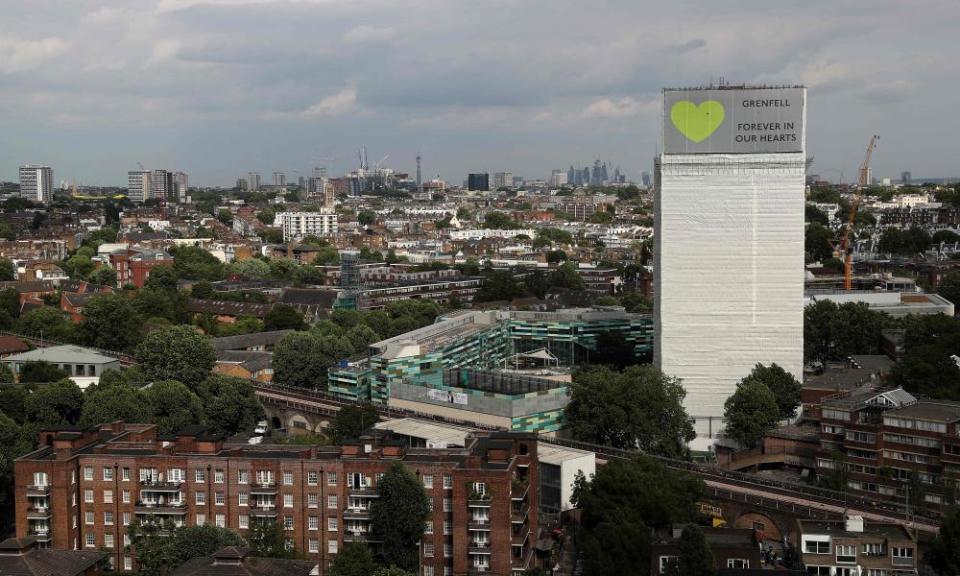Frustration as Grenfell bereaved made to wait until 2020 for answers

The first stage of the Grenfell Tower public inquiry ended this week with a painful crunch. The bereaved, survivors and residents were preparing to mark the passing of 18 months since the fatal blaze on Friday with a silent march and a campaign video fronted by Stormzy restating their demand to “know how the people we trusted to protect us let this happen”. But the chairman, Sir Martin Moore-Bick, confirmed those answers were unlikely to start coming until 2020 because of a major delay to the inquiry.
Disappointment was already simmering before the last of almost 100 days of evidence about the events of 14 June 2017 – both highly detailed and heartbreaking – which were marked by either silence or blame-shifting from many of the companies who worked on the refurbishment. The main contractor Rydon and insulation manufacturer Celotex withdrew at the last minute from making closing submissions to the gathered survivors.
Arconic, which made the cladding, said other materials were responsible for spreading the fire that claimed 72 lives – which one of the bereaved remarked was like saying: “I’ll put a loaded gun in your mouth; it’s up to you if you pull the trigger.” Architect Studio E and Harley Facades, which erected the cladding, did not even file written closing submissions.
One observer said it seemed the companies were embracing “liability culture”: trying to deflect blame, not speaking plainly. The survivors fear more of that to come after the inquiry’s small army of lawyers digests at least 200,000 documents to be disclosed before the second phase exploring how the fatal refurbishment came about. Moore-Bick has given them, and his own team, another year to get their arguments in order.
Nicholas Burton, whose wife, Pily, died from complications after the fire said it appeared to him from some of the evidence that “the insurance companies are behind the scenes saying don’t say anything”.
He said: “These corporations are giving no real explanation. I understand why they are doing it to protect their companies but it is just wrong. We feel like we are being left behind. It is not a public inquiry, it is a lawyers’ inquiry.”
There is frustration at corporate attempts to delay Moore-Bick from issuing conclusions about aspects of building safety – which could affect thousands of other tower residents – until, probably, 2021.
The video made by the survivors’ group Grenfell United (GU) features dozens of the bereaved alongside celebrity backers including the musicians Adele, Marcus Mumford and Akala. It stresses: “It is too late for our loved ones, but it’s not too late for yours.”
GU said companies’ defensiveness and silence was “an insult to our families and continues to put families at risk across the country”.
When the inquiry started in May with eight days of emotional commemorations for the dead, the Grenfell community was cautiously hopeful about the process. It moved six miles east to London’s legal district in June and, before long, fewer of the Grenfell people were coming. Travelling across the city at rush hour while coping with post-traumatic stress disorder and hearing heartbreaking details about what their friends, neighbours and loved ones went through was too tough, as was the logistics of keeping work and family life on track when the commute to the inquiry could easily absorb 90 minutes daily.
“People who should be at the heart of this every day can’t get to it,” said Karim Mussilhy, whose uncle Hesham Rahman – a resident of the 23rd floor – died in the fire. “You have to plan really hard to come to the public inquiry.”
For those that managed, there was some early satisfaction as the inquiry’s scientific experts delivered accounts of how the building performed in the fire. Giving their own accounts of what happened had been liberating for some too, said Burton.
“Every human being wants to tell their story,” he said. “It has been liberating to give that human aspect, the loss, the grief, the mental anguish and to tell the world.”
Shah Ahmed, the former resident of flat 156 who has attended almost every day of the inquiry, said that the process has been “painful” not least because it only allowed survivors such as him a minute or two to lodge additional questions for witnesses. Even then they are asked by the counsel to the inquiry rather than their own lawyers.
“They are not asking the right questions,” Ahmed said. “For me as a bereaved survivor and resident and chair of the leaseholders’ association, this isn’t working. This inquiry is a lawyer’s argument and the bereaved, survivors and residents’ argument should prevail.”
The testimony of Dany Cotton, commissioner of the London fire brigade, was a low point for many. She said she would not do anything different with hindsight and that preparing for a fire such as Grenfell was like preparing for a space shuttle landing on the Shard. It was “a stab in the heart”, said Burton.
“I felt very low that day,” he said. “I wanted to shout out: ‘Shame on you.’”
“It didn’t feel like she was taking it seriously,” added Mussilhy. “You don’t know how tough it was for us to hear that.”
The delay to the second phase of the inquiry has increased fears that momentum will be lost and with that comes the risk, Burton said, of “a dilution of responsibility”.
The delay gives all of the organisations “time to regroup and find wiggle room and loopholes”, fears Mussilhy.
“We don’t have to wait,” he said. “We know the lifts, the insulation, the doors weren’t suitable. We can call these companies out right now and put a stop to these manufacturing processes so these materials are no longer used. This public inquiry has to make sure this fire doesn’t happen again.”

 Yahoo News
Yahoo News 